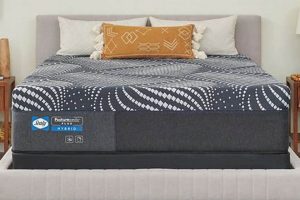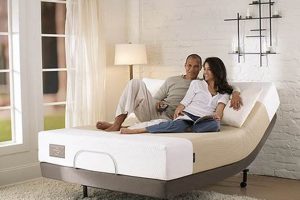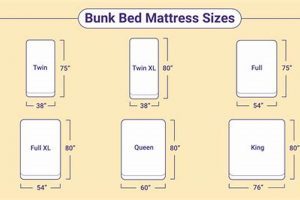A sleep system designed for individualized comfort, this type of bed features two separate queen-sized mattresses placed on an adjustable base. This configuration allows each side of the bed to be independently raised or lowered, catering to different preferences for sleeping positions and support. A standard example would be a couple where one person prefers to sleep elevated due to acid reflux, while the other prefers a flat position.
The importance of such a system lies in its ability to promote better sleep quality for individuals with differing needs or medical conditions. Its benefits include reduced pressure points, improved circulation, and relief from back pain. Historically, adjustable beds were primarily found in hospital settings, but with advancements in technology and a growing awareness of sleep health, they have become increasingly popular in residential environments.
The ensuing sections will delve deeper into the specific components of these systems, including the adjustable base mechanisms, mattress options suitable for these configurations, and the potential advantages and disadvantages of choosing this type of sleep arrangement.
The selection of a compatible system requires careful consideration of multiple factors to ensure optimal comfort and functionality. The following tips provide guidance in making an informed decision.
Tip 1: Research Adjustable Base Mechanisms: Investigate different types of adjustable bed bases, focusing on motor quality, lifting capacity, and available features such as massage or pre-set positions. A robust motor is essential for longevity and reliable operation.
Tip 2: Evaluate Mattress Compatibility: Not all mattresses are suitable for adjustable bases. Latex and memory foam mattresses are generally more flexible and adapt well to the contours of the base. Innerspring mattresses may not conform as readily, potentially affecting comfort and durability.
Tip 3: Consider Individual Sleep Needs: Account for individual preferences and medical conditions when selecting a mattress. Side sleepers may benefit from a softer mattress, while back sleepers may require firmer support. Address any specific needs, such as pressure relief for joint pain.
Tip 4: Assess the Gap Between Mattresses: The division between the two mattresses can be a concern. Look for models that offer methods for minimizing the gap, such as integrated mattress retainers or specialized mattress designs. A significant gap can disrupt sleep quality.
Tip 5: Examine Remote Control Functionality: Evaluate the ease of use and features of the remote control. A user-friendly interface with clear labeling and intuitive controls is crucial for convenient operation. Consider features such as wireless remotes or smartphone app integration.
Tip 6: Verify Warranty and Return Policies: Review the warranty offered by the manufacturer for both the adjustable base and the mattresses. Understand the terms and conditions, including the length of coverage and any limitations. Inquire about return policies in case the system does not meet expectations.
These considerations aim to assist prospective buyers in selecting a system that provides customized comfort, support, and long-term satisfaction. Prioritizing research and thoughtful evaluation is critical to maximizing the benefits of a split queen adjustable bed with mattress.
The subsequent section will discuss the potential drawbacks and challenges associated with this type of bed configuration, offering a balanced perspective.
1. Individualized Comfort
The concept of individualized comfort assumes paramount importance within the context of a split queen adjustable bed with mattress. This sleep system is inherently designed to address varying preferences and needs, fostering a personalized environment that promotes restorative sleep. The following points elaborate on this core tenet.
- Independent Elevation Control
Each side of the bed operates independently, enabling users to adjust the head and foot positions to their specific liking. This feature directly caters to individuals with medical conditions such as acid reflux, sleep apnea, or back pain, allowing them to find optimal sleeping angles that alleviate discomfort. The ability to adjust each side independently also eliminates the compromise often required in traditional bed setups.
- Customized Mattress Selection
While the bed frame offers independent adjustability, the selection of mattresses plays a vital role in achieving individualized comfort. Couples can choose mattresses with different firmness levels or materials to suit their unique body types and sleep preferences. This personalized approach ensures that each person receives the appropriate support and pressure relief, minimizing sleep disruptions and maximizing comfort.
- Reduced Partner Disturbance
The split design inherently minimizes motion transfer between partners. When one person adjusts their side of the bed, the other is less likely to be disturbed by the movement. This is particularly beneficial for light sleepers or individuals who are sensitive to their partner’s tossing and turning. Reduced partner disturbance contributes to a more restful and uninterrupted sleep experience.
- Personalized Feature Integration
Many split queen adjustable bed frames offer additional features such as massage settings, USB charging ports, and under-bed lighting. These features can be personalized to suit individual preferences, further enhancing the overall comfort and convenience of the sleep environment. Integrating these personalized features transforms the bed into a multi-functional space tailored to individual needs.
In essence, the split queen adjustable bed with mattress offers a highly adaptable sleep solution that prioritizes individualized comfort. By providing independent adjustability, customized mattress options, reduced partner disturbance, and personalized feature integration, this system effectively caters to the diverse needs and preferences of couples, promoting restorative sleep and overall well-being.
2. Independent Adjustability
Independent adjustability constitutes a core functional characteristic of a split queen adjustable bed with mattress, offering a significant departure from traditional sleeping arrangements. This feature is fundamental to the system’s ability to provide customized comfort and support to individual sleepers.
- Head and Foot Elevation
The primary function of independent adjustability lies in the separate control of head and foot elevation on each s
ide of the bed. This permits one user to elevate their upper body for purposes such as reducing acid reflux or easing breathing, while the other user may maintain a flat sleeping position. Examples include individuals with sleep apnea who benefit from elevated head positions, or those with lower back pain who find relief in slight knee elevation. This independent control negates the compromise inherent in a standard, non-adjustable bed frame. - Customized Comfort Settings
Beyond basic elevation, many adjustable bases offer programmable memory settings. These settings allow each user to save their preferred positions, enabling quick and effortless adjustments to desired comfort levels. This feature is particularly beneficial for individuals who engage in activities like reading or watching television in bed, or those who require specific sleeping positions due to medical conditions. The customization extends beyond simple elevation, encompassing pre-set positions designed for specific activities or therapeutic purposes.
- Pressure Point Relief
Independent adjustability facilitates targeted pressure point relief. By slightly elevating or contouring the mattress, users can redistribute weight and alleviate pressure on sensitive areas like the hips or shoulders. This feature is especially valuable for individuals suffering from arthritis or other conditions that cause joint pain. The ability to fine-tune the sleeping surface to address specific pressure points contributes to a more comfortable and restorative sleep experience.
- Addressing Medical Needs
The independent adjustability of a split queen bed has direct implications for individuals with various medical conditions. For example, individuals with circulatory issues may benefit from elevating their legs to improve blood flow. Similarly, those with respiratory problems may find relief in elevating their upper body to ease breathing. This targeted support can significantly improve sleep quality and overall well-being for individuals with specific health concerns. The adjustability provides a non-invasive means of addressing symptoms and promoting a more comfortable sleep environment.
These facets of independent adjustability demonstrate its central role in the functionality and appeal of a split queen adjustable bed with mattress. The ability to customize support, address medical needs, and enhance overall comfort underscores the value of this feature in promoting a more personalized and restorative sleep experience.
3. Mattress Compatibility
Mattress compatibility represents a critical factor in maximizing the performance and longevity of a split queen adjustable bed. The design and construction of the mattress must align with the adjustable base to ensure proper articulation, support, and overall comfort. Incompatible mattresses can lead to compromised adjustability, premature wear, and diminished sleep quality.
- Flexibility and Conformability
The mattress must possess sufficient flexibility to conform to the various angles and contours of the adjustable base without sustaining damage or hindering the base’s movement. Mattresses constructed from materials such as memory foam or latex typically exhibit greater flexibility compared to traditional innerspring mattresses. The ability to conform allows for consistent support and pressure relief across different adjustable positions. For example, a rigid innerspring mattress may not bend properly, creating uncomfortable pressure points and potentially damaging the adjustable base mechanism.
- Thickness and Weight Considerations
The thickness and weight of each mattress component must be considered in relation to the adjustable base’s weight capacity and lifting mechanisms. Exceeding the specified weight limits can compromise the base’s functionality and lifespan. Furthermore, excessively thick mattresses may restrict the range of motion or interfere with the base’s articulation. Thinner mattresses might not provide adequate support. Manufacturers typically specify optimal mattress thickness and weight ranges for their adjustable bases, which should be carefully observed. For instance, a heavy hybrid mattress may overload the motors of a base designed for lighter foam mattresses.
- Mattress Retention Systems
The absence of a robust mattress retention system can lead to slippage or shifting during adjustments, particularly with split queen configurations. Many adjustable bases incorporate features like corner retainers or non-slip surfaces to secure the mattresses in place. These systems are essential for maintaining consistent alignment and preventing gaps between the two mattresses. Without proper retention, the mattresses can gradually drift apart, creating discomfort and disrupting sleep. Some mattresses are designed with materials like gel or fabric, on the bottom, which can offer more stability.
- Material Composition and Durability
The composition of the mattress directly influences its durability and suitability for use with an adjustable base. Materials prone to compression or degradation under stress may exhibit premature wear and tear when repeatedly adjusted. High-density foams, reinforced coils, and durable fabric covers are crucial for ensuring long-term performance. Inadequate material composition can result in sagging, indentations, or structural damage to the mattress over time. For example, mattresses with low-density foam or inferior coil systems may not withstand the constant flexing and pressure associated with adjustable bases.
These factors underscore the intricate relationship between mattress compatibility and the overall functionality of a split queen adjustable bed with mattress. Careful consideration of flexibility, thickness, retention, and material composition is imperative to achieving optimal performance, comfort, and durability.
4. Reduced Motion Transfer
Reduced motion transfer is a significant benefit attributed to split queen adjustable bed configurations, particularly relevant for couples with differing sleep schedules or sensitivities to movement. The design inherently minimizes disturbances, contributing to a more restful sleep environment.
- Independent Mattress Support
The presence of two distinct mattresses within the split queen setup is paramount to motion isolation. Each sleeper has their own support system, minimizing the transmission of movements across the bed. Unlike a single, larger mattress where movement reverberates, the split configuration dampens these disturbances. A real-world example includes one partner tossing and turning without significantly impacting the other’s sleep quality. This is particularly beneficial for couples where one partner is a light sleeper or experiences frequent sleep disruptions.
- Adjustable Base Isolation
Quality adjustable bases incorporate design features that further reduce motion transfer. These may include isolated motor systems and frame construction that minimizes vibrations. For example, a well-engineered base will operate quietly and smoothly, preventing the movements of one side from being felt on the other. This isolation is especially important when one partner is adjusting their position, ensuring the other remains undisturbed. The i
ntegration of these features enhances the overall motion isolation capabilities of the bed. - Mattress Material Contribution
The choice of mattress materials significantly influences motion transfer. Memory foam and latex mattresses are known for their ability to absorb movement, while innerspring mattresses tend to transmit more motion. Selecting mattresses with superior motion-absorbing properties complements the split queen design, further enhancing motion isolation. For instance, a couple might choose memory foam mattresses on their respective sides to maximize motion absorption and minimize partner disturbance.
- Minimizing Sleep Disturbances
The combined effect of independent mattresses, base isolation, and motion-absorbing materials significantly reduces sleep disturbances caused by partner movement. This can lead to improved sleep quality, reduced stress levels, and enhanced overall well-being. A tangible benefit is fewer instances of one partner waking up due to the other’s restlessness. The reduced motion transfer contributes to a more consistent and undisturbed sleep cycle for both individuals.
The connection between reduced motion transfer and the split queen adjustable bed system is multifaceted. The design, engineering, and material selection work in concert to minimize partner disturbance, leading to improved sleep quality and a more harmonious sleep environment for couples.
5. Customized Support
Customized support constitutes a primary advantage of a split queen adjustable bed with mattress. This system allows for individualized adjustment of both the sleeping surface and the support it provides, addressing diverse needs and preferences.
- Independent Zone Adjustment
Each side of the split queen adjustable bed offers independent control over different zones, such as the head, lumbar, and leg areas. This allows individuals to fine-tune the bed’s configuration to meet their specific postural requirements. For example, one sleeper may require elevated lumbar support due to chronic back pain, while the other may prefer a flat sleeping surface. The independent zone adjustment caters to these disparate needs without compromise. The ability to adjust each side independently promotes proper spinal alignment and reduces pressure points.
- Variable Firmness Options
Couples can select mattresses with varying firmness levels for each side of the split queen bed. This addresses differences in body weight, sleeping position, and personal preference. One individual may prefer a firmer mattress for back support, while the other may opt for a softer mattress for pressure relief. This customized firmness selection enhances comfort and promotes restful sleep. It also allows for the accommodation of specific medical recommendations. For instance, a heavier individual may require a firmer mattress to prevent spinal misalignment, while a lighter person may find a softer mattress more comfortable.
- Adaptive Material Technology
Modern mattress technologies, such as memory foam and latex, adapt to the individual’s body contours, providing targeted support and pressure relief. These materials conform to the unique shape of each sleeper, distributing weight evenly and minimizing stress on joints and muscles. The adaptive nature of these materials complements the adjustable base, enhancing the overall customized support experience. For example, memory foam can cradle the body and alleviate pressure on sensitive areas like the hips and shoulders, while latex provides responsive support and promotes proper spinal alignment.
- Accommodation of Medical Conditions
Customized support plays a vital role in managing various medical conditions. Individuals with back pain, arthritis, sleep apnea, or acid reflux can benefit from the ability to adjust the bed to specific angles and positions that alleviate their symptoms. For example, elevating the head of the bed can reduce acid reflux, while elevating the legs can improve circulation. The split queen adjustable bed allows each partner to address their unique medical needs without disrupting the other’s sleep. It facilitates a therapeutic sleep environment tailored to individual health requirements.
The facets of individualized zone adjustment, variable firmness, adaptive materials, and medical condition accommodation collectively define the customized support capabilities of a split queen adjustable bed with mattress. This system enables each sleeper to optimize their sleep environment, promoting comfort, health, and overall well-being.
6. Enhanced Sleep Posture
Optimal spinal alignment during sleep is crucial for preventing musculoskeletal pain and promoting restorative rest. The split queen adjustable bed with mattress offers features designed to facilitate enhanced sleep posture, addressing individual needs and preferences that directly impact spinal health.
- Independent Head and Foot Elevation
The capability to independently adjust the head and foot sections of each side of the bed allows for personalized postural correction. For instance, elevating the head slightly can alleviate pressure on the neck and upper back, while elevating the knees can reduce strain on the lower back. Individuals with conditions like spinal stenosis or degenerative disc disease may find significant relief through these customized adjustments. This targeted support facilitates proper spinal curvature and minimizes pressure points that contribute to discomfort and poor sleep quality. The adjustability can be likened to a personalized physical therapy session, guiding the spine into a more neutral and supported position.
- Contoured Mattress Support
The selection of mattresses compatible with adjustable bases often involves materials like memory foam or latex, which conform to the body’s natural contours. This contoured support ensures that the spine maintains its natural alignment, regardless of the sleeping position. Side sleepers, for example, require sufficient cushioning to prevent shoulder and hip compression, while back sleepers need adequate lumbar support to maintain spinal curvature. The split queen configuration allows each partner to choose a mattress that best suits their individual postural needs and sleeping style. This targeted support ensures that the spine is properly aligned and supported throughout the night, minimizing the risk of pain and stiffness.
- Pressure Point Alleviation
Adjustable beds, in conjunction with conforming mattresses, can alleviate pressure on key areas such as the hips, shoulders, and lower back. By redistributing weight and reducing compression, these systems promote improved circulation and reduce discomfort. This is particularly beneficial for individuals with arthritis or other conditions that cause joint pain. The ability to customize the bed’s configuration allows for targeted pressure relief, promoting a more comfortable and restful sleep experience. The reduction in pressure points contributes to improved circulation and reduces the likelihood of waking up with stiffness or discomfort.
- Customized Spinal Alignment
The split queen adjustable bed allows each partner to independently optimize their sleep posture, addressing unique anatomica
l differences and postural needs. This customization extends beyond simple elevation and includes the ability to fine-tune the bed’s configuration to promote proper spinal alignment throughout the night. The benefits extend beyond immediate comfort, potentially mitigating long-term musculoskeletal issues related to poor sleep posture. By promoting proper alignment and reducing pressure points, the system contributes to improved spinal health and overall well-being.
These multifaceted aspects underscore the integral connection between enhanced sleep posture and the split queen adjustable bed with mattress. The capacity for personalized adjustments, combined with compatible mattress technologies, facilitates optimal spinal alignment, pressure relief, and overall comfort, ultimately promoting restorative sleep and improved musculoskeletal health.
7. Partner Synchronization
Partner synchronization, in the context of a split queen adjustable bed with mattress, refers to the ability to coordinate the movements and settings of both sides of the bed. While the primary advantage of a split configuration is independent adjustability, certain models offer features that allow for linked operation. This functionality addresses scenarios where couples desire simultaneous adjustments or seek to maintain a shared sleeping position at times. The presence or absence of synchronization capabilities significantly impacts the user experience and overall utility of the bed system. The absence of synchronization can pose challenges when couples seek to transition between positions or share activities like watching television.
The inclusion of partner synchronization features can range from basic remote controls that allow for simultaneous adjustments to more advanced systems with programmable presets. Some systems allow for partial synchronization, where only certain functions, such as head elevation, are linked, while others maintain full independence. The implementation of these features often involves sophisticated control systems and motor mechanisms. The selection of a system with appropriate synchronization capabilities depends on the specific needs and preferences of the users. For example, couples who frequently share activities in bed may benefit from a system with comprehensive synchronization options. The absence of this feature could lead to less convenient adjustments and a diminished sense of shared space.
Partner synchronization serves as a supplementary, yet potentially valuable, function within the broader framework of split queen adjustable beds. While the independent adjustability remains the core benefit, the ability to link the two sides caters to specific user needs and preferences. The effectiveness of synchronization features depends on their design, implementation, and integration with the overall bed system. Careful consideration of these factors is essential when evaluating the suitability of a particular model. Furthermore, the understanding of partner synchronization can assist users in optimizing their sleep environment.
Frequently Asked Questions
The following questions address common inquiries and concerns regarding split queen adjustable bed configurations with mattresses.
Question 1: What distinguishes a split queen adjustable bed from a standard queen adjustable bed?
A split queen adjustable bed consists of two separate queen-sized mattresses positioned on an adjustable base, enabling independent adjustment of each side. A standard queen adjustable bed features a single queen mattress on a single adjustable base, allowing for simultaneous adjustment across the entire surface.
Question 2: Is there a noticeable gap between the mattresses in a split queen configuration, and how can it be minimized?
A gap may be present between the mattresses. Its prominence depends on mattress design and base construction. Certain manufacturers incorporate features such as mattress retainers or bridge designs to minimize this gap and enhance sleep surface continuity.
Question 3: Are specific mattress types required for use with a split queen adjustable base?
While not strictly required, mattresses with high flexibility, such as memory foam or latex models, are generally recommended. These materials conform readily to the adjustable base’s contours without compromising support or durability. Innerspring mattresses may exhibit limited flexibility and reduced longevity when used on an adjustable base.
Question 4: Can one side of a split queen adjustable bed be raised while the other remains flat?
Yes, independent adjustability is a defining characteristic of split queen adjustable beds. Each side functions autonomously, allowing one user to elevate their head or legs while the other maintains a flat sleeping position.
Question 5: What are the potential drawbacks of a split queen adjustable bed with mattress?
Potential drawbacks include the initial cost, which may exceed that of standard bed systems. The presence of a gap between mattresses, while often minimized, can be a concern for some users. Also, the weight and complexity of the system can pose challenges during setup and relocation.
Question 6: How does the weight capacity of the adjustable base affect mattress selection?
The adjustable base’s specified weight capacity must be considered when selecting mattresses. Exceeding the weight limit can compromise the base’s functionality, shorten its lifespan, and potentially void the warranty. Mattress weight should be within the manufacturer’s recommended range.
Understanding these key aspects facilitates informed decision-making regarding split queen adjustable bed systems.
The subsequent section will delve into the long-term considerations of owning this type of bed.
In Conclusion
This exploration of the split queen adjustable bed with mattress has illuminated its defining characteristics: individualized comfort, independent adjustability, mattress compatibility considerations, and potential for enhanced sleep posture. The benefits of reduced motion transfer and the option for partner synchronization have also been examined. The information presented enables a balanced assessment of this sleep system.
The decision to invest in a split queen adjustable bed with mattress should stem from a careful evaluation of individual needs and preferences. Understanding the functionalities, potential drawbacks, and long-term considerations is paramount. Further research into specific models and brands is recommended to ensure the selected system aligns with intended use and desired outcomes. The future of sleep technology will likely bring further innovations in this area, demanding continued vigilance and adaptation from consumers.






![Best Truck Bed Mattress [Your Adventure Bed Starts Here] Organic & Natural Mattress Buyer’s Guide: Non-Toxic Sleep Solutions Best Truck Bed Mattress [Your Adventure Bed Starts Here] | Organic & Natural Mattress Buyer’s Guide: Non-Toxic Sleep Solutions](https://mattressworldpa.com/wp-content/uploads/2025/07/th-7122-300x200.jpg)
![Best Floor Bed Mattress [Guide] - Sleep Soundly! Organic & Natural Mattress Buyer’s Guide: Non-Toxic Sleep Solutions Best Floor Bed Mattress [Guide] - Sleep Soundly! | Organic & Natural Mattress Buyer’s Guide: Non-Toxic Sleep Solutions](https://mattressworldpa.com/wp-content/uploads/2025/07/th-7121-300x200.jpg)